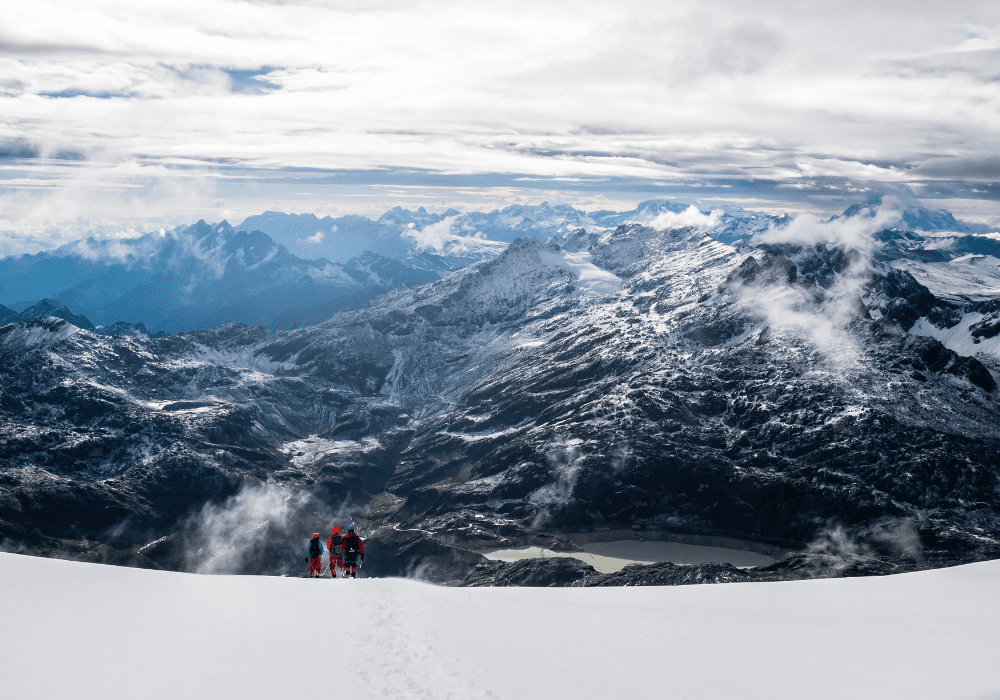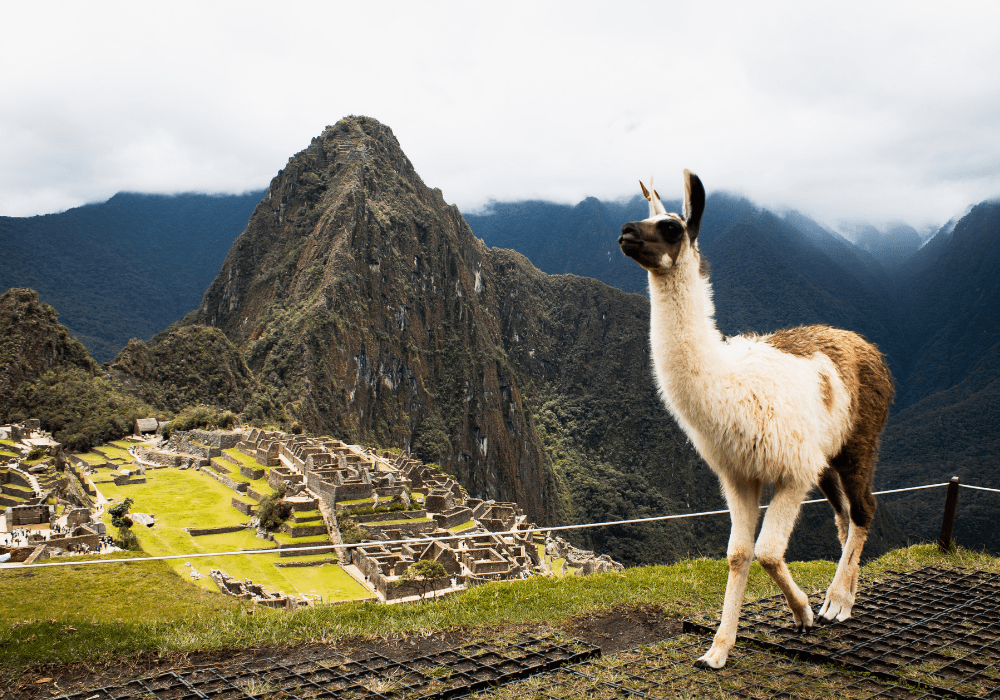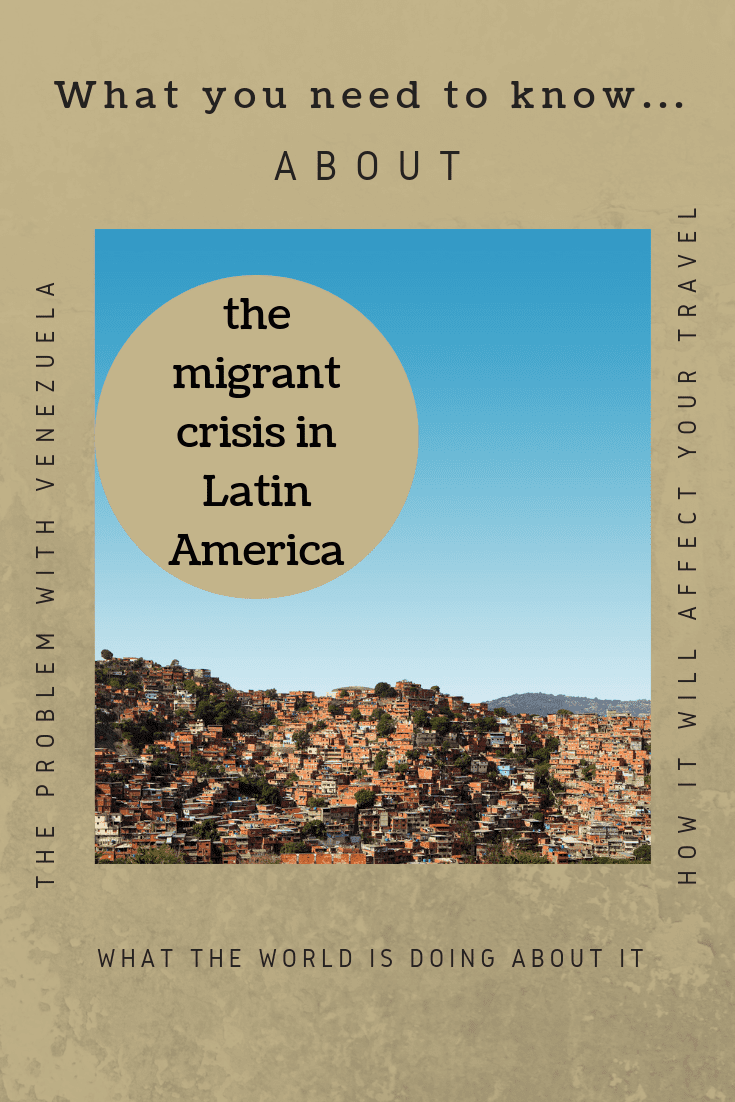Things that might make someone choose to travel by foot over 2,000 miles into uncertainty:
A life’s savings depleted by hyperinflation.
Essential food products are missing from the local shops.
No medicine in your pharmacy and a non-functional hospital.
A lack of electricity and running water.

In 1984, ten Latin American countries signed the Cartagena Declaration on Refugees, which defines refugees as “persons who have fled their country because their lives, safety, or freedom have been threatened by generalized violence, foreign aggression, internal conflicts, massive violation of human rights, or other circumstances which have seriously disturbed public order.” The region also has some of the most advanced laws regarding migrants and refugees in the world.
(In other parts of the world the 1951 Refugee Convention is used to define a refugee.)
A Crisis of Name
Currently, the people fleeing Venezuela are considered mostly migrants. The UN refugee agency (UNHCR) has referred to it as a “mixed flow” of migrants and refugees. This is understandable. A full-blown refugee crisis comes with a significant amount of increased responsibility than that of a mere ‘migrant crisis.
The Numbers Game
There is no agreement on the figures. It is, however, safe to say that over 2.3 million Venezuelans—roughly 7 % of the entire population—have fled the country’s political and economic crisis since 2014, the most significant human displacement in Latin America’s history.
At some point as many as 5,000 Venezuelans were crossing the border into Brazil, Chile, Colombia, Ecuador and Peru every day.
Some think the total number of migrants may be as high as 4 million.

A Different Venezuela
Venezuela is in a unique position as it is the poster child for an open door immigration policy.
Integration policies were established in the late nineteenth century as Guzmán Blanco invested in mixed colonies with migrants working alongside natives.
It was also among the first countries to officially embrace the creation of the International Refugee Organization (precursor to the Office of the United Nations High Commissioner for Refugees) to assist European immigrants after World War II.
In 1945 Eduardo Mendoza Goiticoa, the minister of agriculture, promoted immigration to boost the economy of Venezuela and the country welcomed tens of thousands of European refugees from Italy, Spain, Portugal, Germany, Hungary, Romania, Czechoslovakia, Lebanon, and Syria. Mendoza’s policies would survive into the 1970s with more migrants from Argentina, Colombia, Chile, Ecuador, and Peru.
Now, following the reign of President Hugo Chávez and Nicolás Maduro, many of Venezuela’s immigrants have fled again.
 The Reception
The Reception
Most Latin American governments have welcomed the refugees in a continent that may be the most culturally integrated region in the world. The countries of South America widely share language, religion, and culture.
This does not mean that the refugee crisis is taking place without any disruption. In Peru and Brazil mainly there has been some pushback.
Evidence about refugees from across the globe show that:
- New migrants do not usually displace locals from jobs or change salary structures. In places where this has been noted the changes were temporary and minimal.
- Refugees are usually ‘risk takers,’ and this makes them good at creating businesses (in some cases eventually employing locals.)
- When they are employed, refugees are highly unlikely to engage in criminal activities.
Integration is the fastest way for migrants to contribute to a community visibly. And integration happens when migrants know they can remain for the medium to long term with an opportunity to work and access to health care and education.
In Latin America, countries have found ways to welcome Venezuelans with proper documentation officially. Unfortunately, the problems in Venezuela have resulted in passports not being available (or Venezuelans having to pay almost 70 times the monthly minimum wage to expedite passport issuance!).
For two years, the countries of South America welcomed over two million Venezuelans. The trend is much more generous than anywhere else in the world. But the capacity is now being reached.
At present, Venezuelans leaving the country continue to be considered migrants. If they are recognized as refugees, the situation will be significantly altered.
In Venezuela, poor people, women, children and public critics of the regime suffer human rights violations, lack fundamental freedoms and may be subjected to arbitrary detention and torture. The population also suffer from a government led lack of health care, food, and education. There is no humanitarian assistance in Venezuela.
In Caracas, access to social programs and subsidies is dependent on having a ‘Fatherland ID’ which tracks and collects information about voting behavior.
Venezuelans are not choosing to leave. They are fleeing for their lives.
The United Nations warns of a crisis point comparable to the situation in the Mediterranean in 2015. President Michel Temer of Brazil has warned of a threat to the peace in all of South America.
 Brazil
Brazil
In August 2018, there were clashes in the border between Brazil and Venezuela. In Brazil, efforts are being made to relocate Venezuelans from the isolated north of the country to bigger cities to help them find work and settle.
Anti-migrant sentiment on the Brazilian frontier is growing. Local officials in some border cities now require passports and special permits to access government services. Others have set up separate migrant-only bathrooms. The Brazilian military was even deployed to the border to keep the peace.
Colombia
In Colombia, work permits are available to Venezuelans migrants who entered the country legally or illegally.
Ecuador
Ecuador also restricted entry to individuals with passports.
The restriction was overturned by a judge, but the country has declared a state of emergency in the areas of the country most affected by the migration.
Ecuador also hosted a summit ending in an 18-point declaration signed by 11 countries in the region. The declaration agrees to more extensive cooperation, sharing information and extra support for countries like Colombia that are most affected.
Peru
In Peru, a Venezuelan passport is the only acceptable method for entry.
The United States
Former US Ambassador to the UN, Nikki Haley, has called on the UN Security Council members to take more concrete action against Venezuela. But there is little prospect of an agreement as there have to be specific conditions (a higher level of violence threatening international peace) to merit a response from the UN Security Council. And there is also the matter of Venezuelan allies Russia and China being permanent Security Council members.
The US has given over $46 million in humanitarian aid, and US President Trump has threatened military action. Unfortunately, the current restrictionist policy towards immigrants and refugees in the US will not make it easy for America to play a leadership role and force countries to act with even more grace towards Venezuelan migrants.
 A Regional Economic Disaster
A Regional Economic Disaster
Former Argentinian Minister of Foreign Affairs, Susana Malcorra, said: “If Brazil sneezes, we [Argentina] have pneumonia.”
Since 2011, the national struggles of Venezuela have spread throughout the region with Brazil affecting Argentina and Argentina destabilizing the economies of Paraguay, Uruguay, and Bolivia. The region is succumbing to social, economic and political turmoil.
In Brazil (representing at least a third of the economy of Latin America) the Lava Jato corruption scandal resulted in plummeting commodity prices and fiscal deficit. The result of the economic crisis was a decrease of 7.4 percent in the GDP between 2015 and 2016 which in turn resulted in a 0.47 percent contraction in growth throughout Latin America in 2016.
Uncertainty continues regarding Brazilian politics, and its neighbors continue to suffer the consequences.
Argentina has also been hit by the worst drought in the last 50 years. Failed austerity measures, political drama corruption, and global trade wars resulted in the Argentinian peso losing 50% of its value against the dollar in the first six months of 2018. And THAT culminated in a historic $56.3 billion IMF loan to Argentina.
Bolivia
The government decided to place tariffs on Argentinian products to avoid dumping.
Colombia and Panama
Economic activity has sharply declined. Colombia has received around 1 million of the 2 – 4 million Venezuelans who left Venezuela.
Paraguay
Border transactions previously benefited Paraguay but now Paraguayans cross into Argentina to spend their money and business is declining in their own country.
Uruguay
The collapse of the Argentinian Peso has forced Uruguay to sell $500 million and remove VAT for foreigners to incentivize tourism.
Venezuela
The country seems to be in a flat spin with rampant inflation (projected at 1million % by the IMF) and economic decline in the double-digit contractions. Purchasing power is declining oil prices are plummeting, and governance is inefficient. The Venezuelan oil and gas industry represents 90% of its exports and production is dropping due to a lack of maintenance and investment.
It is true. In Latin America, both growth and stagnation spread through the region. Often in answer to changes in Argentina, Brazil, and Venezuela.
 The Immediate future
The Immediate future
Argentina may be moving more towards the center but needs to resolve all political dramas and economic debacles. Brazil currently has a radical military right-wing government, and the future will remain gloomy until a new government can take power. In Venezuela, the government remains stable with the fragmentation and division of opposition parties strengthening its position. Unfortunately, there are very few options remaining to revive the country’s economy.
What does this all mean for travel to South America?
As with travel to Africa (or elsewhere), a reputable Travel Designer will rely on first-hand information when determining the safety of a destination. Currently, except for Venezuela, South America is considered on the same advisory level as travel to the United Kingdom – Level 2 Exercise increased caution.
Peru, Chile, and Argentina are all at a Level 1 – Exercise normal precautions.
Travel to Venezuela
As recently as 25 years ago Venezuela was the standard entry point to South America. Many travelers would stop over in Caracas on their way to the beaches of the Caribbean. (The island of Trinidad is only 11 km from Venezuela)
Today, the cruise ships of the Caribbean no longer stop in Venezuela.
Travel to Venezuela and areas up to 80 km from the border in Colombia and up to 40 km from the border in Brazil is not advisable at present. Ongoing crime and instability, poor health infrastructure, and arbitrary arrest and detention of US citizens mean that all but essential travel should not be undertaken.
US State Advisory Level 4
Travel to Argentina
Exercise only normal caution for travel to Argentina.
US State Advisory Level 1
Travel to Brazil
Crime rates are high as usual in Brazil, but travel should be trouble-free. The border region with Venezuela should be avoided.
US State Advisory Level 2
Travel to Chile
Exercise normal caution when traveling to Chile
US State advisory Level 1
Travel to Colombia
It is broadly safe to visit Colombia, and the traditional tourist itineraries including Bogota Medellin and Cartagena are considered safe. Do not travel throughout the rest of the country and in the areas bordering Venezuela and Ecuador.
US State Advisory Level 2
Travel to Ecuador
It is broadly safe to visit Ecuador with crime indicated in some areas.
US State Advisory Level 2
Travel to Peru
It is considered safe to travel to Peru when exercising normal caution.
US State Advisory Level 1
………..
Travel Insurance and the Refugee/Migrant Crisis
Please note: We cannot know the particulars of your personal travel insurance.
The typical insurance policy wording rejects any claim “arising as a result of your travel to a country or specific area or event to which the Travel Advice Unit of the Foreign and Commonwealth Office or the World Health Organisation or the US Department of State has advised the public not to travel.”
This does not apply if the warning was issued after the traveler arrived in the country, but they will be expected to make arrangements to leave rather than remain exposed to risk.

Imagery © Fabien Moliné – unsplash.com; © Arto Marttinen – unsplash.com; © Toomas Tartes – unsplash.com; © Rodrigo Flores – unsplash.com; © Ben Ostrower – unsplash.com; © Junior Moran – unsplash.com

